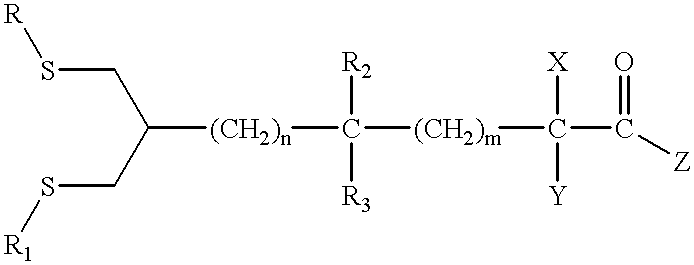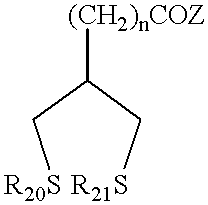Antioxidants
a technology of antioxidants and lipids, applied in the field of antioxidants, can solve the problems of skin dryness, loss of stratum corneum water, and skin dryness
- Summary
- Abstract
- Description
- Claims
- Application Information
AI Technical Summary
Benefits of technology
Problems solved by technology
Method used
Image
Examples
example 1
A leave-on lotion composition containing benzoyl peroxide is prepared by combining the following ingredients using conventional mixing techniques.
In a suitable vessel, the Phase A ingredients are heated with stirring to about 75 degree C. In a separate vessel, the Phase B ingredients are heated with stirring to about 75 degree C. Phase B is then added to Phase A with mixing. Next Phase C is added with mixing. Next, the mixture is cooled to 35 degree C. Next the active lipoic acid derivative, synthesized as described in this invention, is added with mixing. In a separate vessel, the Phase E ingredients are combined and added to the remaining mixture with stirring.
The resulting leave-on composition is useful for preventing and treating acne (including rosacea) while being mild to the skin. Alternatively, a composition is prepared in which the cetyl dimethyl betaine is replaced with stearyl dimethyl betaine.
example 2
A personal cleanser composition containing salicylic acid is prepared by combining the following ingredients using conventional mixing techniques.
In a suitable vessel, the Phase A ingredients are heated with stirring to about 75 degree C. In a separate vessel, the Phase B ingredients are heated with stirring to about 75 degree C. Phase B is then added to Phase A with mixing. Next, the oxidized polyethylene beads are added slowly with mixing to prevent agglomeration. Next the fragrance is added with mixing. Next, the mixture is cooled to 35 degree C. In a separate vessel, the Phase D ingredients are combined and added to the remaining mixture with stirring (typically these ingredients are available as aqueous solutions and are combined as such).
The resulting cleansing composition is useful for preventing and treating skin damage induced by sunlight (UV radiation) and for cleansing the skin. Alternatively, a composition is prepared in which the sodium lauryl sulfate is replaced with s...
example 3
A personal cleanser is prepared by combining the following ingredients using conventional mixing techniques.
In a suitable vessel, the Phase A ingredients are heated with stirring to about 75 degree C. In a separate vessel, the Phase B ingredients are heated with stirring to about 75 degree C. Phase B is then added to Phase A with mixing. Next the fragrance and menthol are added with mixing. Next, the mixture is cooled to 35 degree C. In a separate vessel, the Phase D ingredients are combined and added to the remaining mixture with stirring (typically these ingredients are available as aqueous solutions and are combined as such).
The resulting cleansing composition is useful for cleansing the skin, for preventing or ameliorating skin dryness and wrinkle formation in the skin, for preventing thinning of the skin, for increasing the thickness, hydration and pliability of the skin, and for inhibiting the aging process in skin. Alternatively, a composition is prepared in which the menthol...
PUM
| Property | Measurement | Unit |
|---|---|---|
| body weight | aaaaa | aaaaa |
| weight | aaaaa | aaaaa |
| weight | aaaaa | aaaaa |
Abstract
Description
Claims
Application Information
 Login to View More
Login to View More - R&D
- Intellectual Property
- Life Sciences
- Materials
- Tech Scout
- Unparalleled Data Quality
- Higher Quality Content
- 60% Fewer Hallucinations
Browse by: Latest US Patents, China's latest patents, Technical Efficacy Thesaurus, Application Domain, Technology Topic, Popular Technical Reports.
© 2025 PatSnap. All rights reserved.Legal|Privacy policy|Modern Slavery Act Transparency Statement|Sitemap|About US| Contact US: help@patsnap.com



